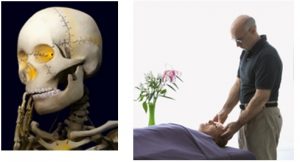Craniosacral therapists believe that the bones of the skull move in a rhythmic pattern which they can detect and correct.

I must admit, I’ve had craniosacral therapy (CST) done on me once and it felt good; I fell asleep. The truth is that I can fall asleep anywhere including on my couch. This relaxation and falling asleep was perhaps a bit better, because I had someone I trusted gently cradle my head for an hour.
As you may know I am a person of science and fully open to new ideas. If something in medicine is supported by the scientific approach, it becomes “main stream” medicine, if it cannot be supported by science it becomes “alternative medicine”.
If it can be proven by the scientific approach, then it is no longer “alternative” but “main stream”.
In one study, two osteopaths, both with post-graduate training in using cranial techniques, palpated 11 normal healthy subjects. The simple conclusion was that the inter-rater reliability for the palpation at the head and the sacrum was poor to nonexistent. 1
Craniosacral therapists claim that they are able to palpate cyclical movements of the skull; however based on the poor agreement amongst practitioners this paper suggested that CST practitioners may simply be imagining such motion. 2
Basically CST practitioners cannot identify the purported craniosacral pulse, and different practitioners will get different results for the same patient.
I once attended a course where an osteopath/chiropractor instructor palpated my head and then within the hour I got the 3 osteopath course assistants to also feel my skull. Not surprisingly all 4 of them claimed that different things were “wrong” with my skull. Fortunately I was asymptomatic or else I would have been scared senseless by the fact that my right frontal lobe and my zygomatic arches were not moving.

A study on rabbits showed that low loads of force, similar to those used in CST, resulted in no changes in coronal suture movement or intracranial pressures.3
“Despite more than 50 years of investigation & the promotion of CST by some practitioners, there remains a void in credible evidence supporting the ability of these techniques to alter the movement of the cranial sutures or improve patient-centered outcomes. … The time is past due for advocates of CST to contribute well-designed studies evaluating the efficacy of these techniques to the peer-reviewed literature. The challenge is clear: prove that it works, or move on.” Flynn et al, 2006, Journal of Orthopaedic & Sports Physical Therapy 4
There is one clinical trial on chronic neck pain that demonstrated that CST was more effective than light placebo touch 5. However when reading the paper one cannot help but see the bias present in the CST practitioners who wrote the study.
The first sentence of the abstract starts with “With growing evidence for the effectiveness of craniosacral therapy (CST) for pain management…”.
I would simply like to ask what “growing evidence”? What are they talking about? There is no growing evidence.
Bias aside, we are still waiting for this 2015 study to be replicated just ONE more time by a different group of researchers… I think we will be waiting for a while.
There is, however, another team of researchers in Spain that have published a few supportive studies on CST in the Journal of Complementary Therapeutic Medicine which are again quite biased. 6
“A proof is a proof. What kind of a proof? It’s a proof. A proof is a proof. And when you have a good proof, it’s because it’s proven.” Jean Chretien
- Moran RW, Gibbons P. Intraexaminer and interexaminer reliability for palpation of the cranial rhythmic impulse at the head and sacrum. J Manipulative PhysiolTher. 2001 Mar-Apr;24(3):183–190.
- Wirth-Pattullo V, Hayes KW. Interrater reliability of craniosacral rate measurements and their relationship with subjects’ and examiners’ heart and respiratory rate measurements. Phys Ther. 1994 Oct;74(10):908–16; discussion 917–20.
- Downey PA et al Craniosacral therapy: the effects of cranial manipulation on intracranial pressure and cranial bone movement. J Orthop Sports Phys Ther. 2006 Nov;36(11):845-53.
- Flynn TW, Cleland JA, Schaible P. Craniosacral therapy and professional responsibility. J Orthop Sports Phys Ther. 2006 Nov;36(11):834–6.
- Haller H, Lauche R, Cramer H, et al. Craniosacral Therapy for the Treatment of Chronic Neck Pain: A Randomized Sham-controlled Trial. Clin J Pain. 2015 Sep.
- Castejón-Castejón M et al Effectiveness of craniosacral therapy in the treatment of infantile colic. A randomized controlled trial. Complement Ther Med. 2019 Dec;47:102164.

